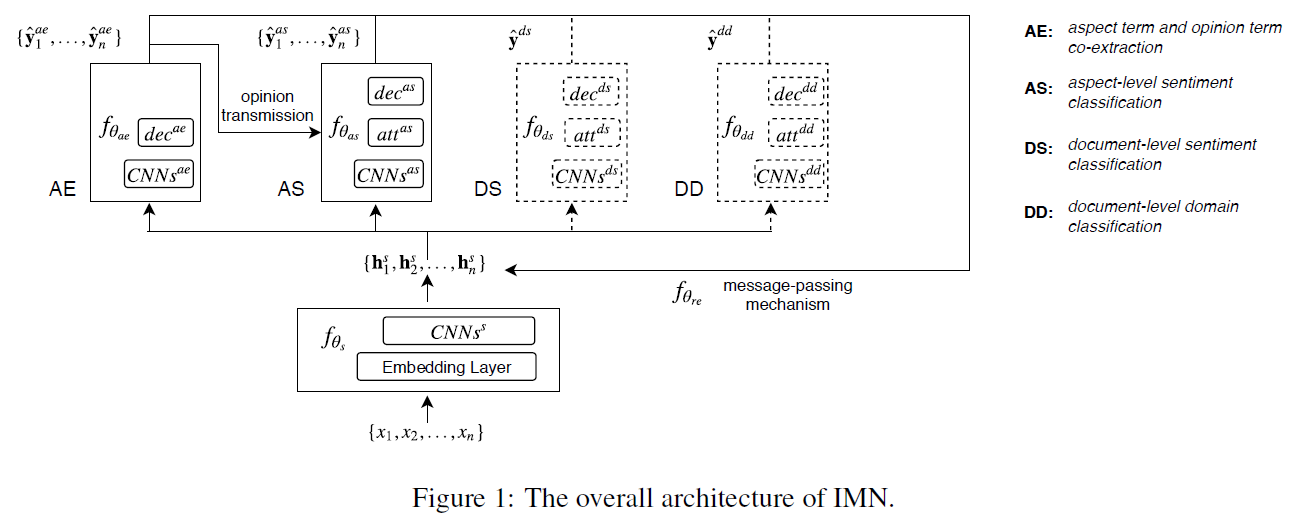An Interactive Multi-Task Learning Network for End-to-End Aspect-Based Sentiment Analysis (2019)
Contents
- Abstract & Introduction
- Related Work
- Proposed Method
- Aspect-level Tasks
- Document-level Tasks
- Message Passing Mechanism
0. Abstract & Introduction
ABSA : 주로 pipeline 방식으로 수행
- step 1) aspect term extraction
- step 2) sentiment prediction
위 방법의 문제점?
- (문제 1) 두 개의 subtask의 joint information을 충분히 활용하지 못해
- (문제 2) document-labeled sentiment corpus 등의 정보도 활용 X
이 논문에서는 위 문제들을 극복할 Interactive Multi-task learning Network (IMN)을 제안한다
-
특징 1) JOINTLY learn multiple related tasks simultaneously \(\rightarrow\) (문제 1) 극복
at both TOKEN level & DOCUMENT level \(\rightarrow\) (문제 2) 극복
-
특징 2) Novel message passing mechanism \(\rightarrow\) (문제 1) 극복
( tasks들 사이의 informative interaction을 가능케함! )
- (a) 그러한 information은 shared latent representation에 combine됨
- (b) not only shared features, but also EXPLICIT INTERACTION
-
특징 3) document-level classification task 도 함께 수행
1. Related Work
(a) ABSA
- 생략
(b) Multi-task learning
전통적인 Multi-task : (1) & (2) 사용
- (1) shared feature spaces
- (2) task-specific feature spaces
\(\rightarrow\) capture CORRELATIONS between tasks & improve MODEL GENERALIZATION ability
문제점 : 기존의 multi-task learning은 “EXPLICLITY(명시적으로)” task들 사이의 interaction을 모델링하지는 못한다! \(\rightarrow\) IMN은 가능해!
- 1) [implicitly] latent representation을 공유할 뿐만 아니라,
- 2) [explicitly] interaction between tasks를 iterative message passing scheme을 통해 잡아내!
Message Passing Architecture
-
message passing graphical model inference algorithms
( RNN 아키텍쳐 자주 사용함 )
-
이 논문 또한 이 아이디어를 사용!
-
propagate information in network
-
learn the update operators
-
-
매 iteration마다 shared latent variable를 update한다
2. Proposed Method
Notation
-
input : \(\{x_1,..,x_n\}\)
-
feature extraction component : \(f_{\theta_s}\)
( shared across tasks )
\(f_{\theta_s}\) ( feature extraction component )
-
구성 1) word embedding layer
-
구성 2) CNN을 통한 feature extraction
-
output of \(f_{\theta_s}\) : sequence of latent vectors, \(\left\{\mathbf{h}_{1}^{s}, \mathbf{h}_{2}^{s}, \ldots, \mathbf{h}_{n}^{s}\right\}\)
\(\rightarrow\) 이 output은 각기 다른 task-specific components의 input으로 들어간다
AE/AS/DS/DD task 각각 수행한다!
-
매 iteration마다, 각 task (AE혹은 AS)에서 나온 최종 정보들은 다시 passed back 되어서
shared latent vectors에 combined 된다. ( 그림 참조 )

2-1) Aspect-level Tasks
AE
- extract all the Aspect & Opinion terms in sentence
- sequence tagging ( BIO tagging 문제 )
- \(Y^{a e}=\{B A, I A, B P, I P, O\}\).
- parameter & output : \(f_{\theta_{a e}}\) & \(\left\{\hat{\mathbf{y}}_{1}^{a e}, \ldots, \hat{\mathbf{y}}_{n}^{a e}\right\} .\)
- encoder : \(m^{a e}\) layers of CNNs
- map into shared representations : \(\left\{\mathbf{h}_{1}^{a e}, \mathbf{h}_{2}^{a e}, \ldots, \mathbf{h}_{n}^{a e}\right\}\)
AS
- (classification X) sequence tagging 문제로써 푼다! ( AE랑 맞춰주기 위해서 )
- \(Y^{a s}=\{\) pos, neg, neu \(\}\)
- encoder : \(m^{a s}\) layers of CNNs
- map into shared representations : \(\left\{\mathbf{h}_{1}^{a s}, \mathbf{h}_{2}^{a s}, \ldots, \mathbf{h}_{n}^{a s}\right\}\)
- AS encoder의 경우, AE encoder과는 다르게, 추가적으로 self-attention layer를 CNN위에 넣는다.
2-2) Document-level Tasks
핵심 취지 : exploit knowledge from DOCUMENT-level classification tasks
- 위의 3-1)과 마찬가지로, DS & DD 수행
2-3) Message Passing Mechanism
서로 다른 tasks들 사이의 interaction을 잡아내기 위해 사용!
- 직전 iteration의 여러 tasks들의 prediction 값들을 aggregate한다
- 이 knowledge를 shared latent vectors \(\left\{\mathbf{h}_{1}^{s}, \mathbf{h}_{2}^{s}, \ldots, \mathbf{h}_{n}^{s}\right\}\)를 update하는데에 사용
\(\begin{aligned} \mathbf{h}_{i}^{s(t)}=& f_{\theta_{r e}}\left(\mathbf{h}_{i}^{s(t-1)}: \hat{\mathbf{y}}_{i}^{a e(t-1)}: \hat{\mathbf{y}}_{i}^{a s(t-1)}:\right. \left.\hat{\mathbf{y}}^{d s(t-1)}: a_{i}^{d s(t-1)}: a_{i}^{d d(t-1)}\right) \end{aligned}\),
